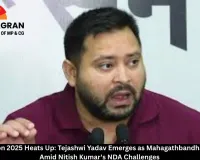Air Marshal Awadesh Kumar Bharti: The Visionary Behind India’s Operation Sindoor
Digital Desk

Air Marshal Awadesh Kumar Bharti stands as one of the most transformative leaders in the history of the Indian Air Force (IAF). Revered as the architect of Operation Sindoor, India’s 100-hour war of precision in May 2025, he redefined the contours of modern aerial warfare through speed, technology, and morality. Under his stewardship, the IAF emerged as a force of unmatched precision and ethical strength, upholding India’s enduring principle of Dharma Yuddha — righteous warfare.
Born in Uttar Pradesh into a family with a proud military heritage, Bharti’s brilliance was evident early on. A graduate of the National Defence Academy, Khadakwasla, he was commissioned as a fighter pilot and swiftly gained reputation for tactical expertise and technical mastery. Operating aircraft ranging from the MiG-21 to the Rafale, he honed his leadership through border defence operations and high-risk commands that shaped his strategic acumen.
His rise through the ranks reflected vision and reform. As a squadron commander, Bharti drove record sortie performances. As Air Officer Commanding, he pioneered AI-supported logistics. Later, as Assistant Chief of Air Staff (Operations), he led digital transformation within the IAF, enabling real-time data and intelligence sharing. Elevated to Air Officer Commanding-in-Chief of the Western Air Command just before Operation Sindoor, he embodied precision leadership and strategic adaptability.
Operation Sindoor marked the pinnacle of his command. In the aftermath of the Pahalgam massacre in May 2025, Air Marshal Bharti orchestrated India’s swift aerial response — a campaign marked by coordination, accuracy, and restraint. Combining satellite intelligence, DIA and RAW inputs, and AI algorithms, he ensured zero collateral damage while achieving total air superiority within 48 hours. Over 120 aircraft — Rafale, Tejas Mk1A, Mirage 2000 — executed synchronized strikes, supported by drone swarms and electronic warfare units that crippled enemy defenses. In just 100 hours, nine terror camps were destroyed and 70 high-value targets neutralized with minimal casualties.
Renowned for calm decisiveness, Bharti’s leadership balanced innovation with empathy. He encouraged experimental tactics and prioritized the well-being of his personnel, personally visiting forward bases to motivate young airmen. Colleagues remember him as a leader “who made technology human and made humans feel superhuman.”
After Operation Sindoor, his stature earned global recognition. The U.S., France, and Israel studied his methods as a model for short-duration precision warfare. Under his direction, the IAF expanded indigenous production, introduced 24×7 rapid deployment systems, and established the Centre for Aerial Robotics and AI Warfare. Awards such as the PVSM, AVSM, YSM, and international honours including France’s Legion of Honour crowned his distinguished career.
Air Marshal Bharti’s legacy is defined by his pursuit of ethical power. Advocating AI, quantum computing, and drone warfare integration, he envisions a future-ready IAF dominant across air, space, and cyber domains. To him, air power is a shield of protection, not destruction. His leadership has transformed the IAF into a symbol of technological strength and moral purpose — ensuring that India’s skies remain guarded with honour, precision, and peace.











